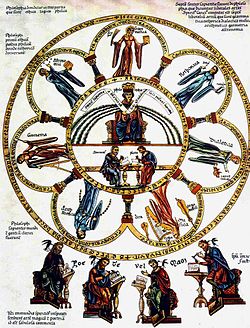Liberal arts education

Liberal arts are the skills derived from the Classical education curriculum.
History
Definition
The term liberal arts denotes a curriculum that imparts general knowledge and develops the student’s rational thought and intellectual capabilities[vague], unlike the professional, vocational, technical curricula emphasizing specialization. The contemporary liberal arts comprise studying art, literature, languages, philosophy, politics, history, mathematics, and science. [1] In classical antiquity, the liberal arts denoted the education proper to a free man (Latin: liber, “free”), unlike the education proper to a slave. In the 5th Century AD, Martianus Capella academically defined the seven Liberal Arts as: grammar, dialectic, rhetoric, geometry, arithmetic, astronomy, and music. In the medieval Western university, the seven liberal arts were:
The Visual Arts
The liberal arts include the visual arts. Renaissance supporters of the visual arts — architecture, painting, sculpture, classed as mechanical and manual arts — argued their inclusion to the liberal arts; among said advocates were Leon Battista Alberti, Leonardo da Vinci, and Giorgio Vasari. In Italy, and among Renaissance humanists, the academic matter was decided around 1500, [2] yet it required another century in Spain and England.
Liberal arts colleges in the United States
In the United States, Liberal arts colleges are schools emphasising undergraduate study in the liberal arts. A full-time, four-year course of study earns the student either a Bachelor of Arts degree or a Bachelor of Science degree; on completing undergraduate study, students might progress to either a graduate school or a professional school (public administration, business, law, medicine, theology). The teaching is Socratic, to small classes, and at a greater teacher-to-student ratio than at universities; classes are taught by full-time teachers, rather than research professors or graduate student teaching assistants as is common at universities. Despite the European origin of the liberal arts college, [3] the term liberal arts college usually denotes liberal arts colleges in the United States.
References
- ^ "Liberal Arts: Encyclopedia Britannica Concise". Encyclopedia Britannica.
- ^ Blunt, Anthony, Artistic Theory in Italy, 1450-1660,p. 49, 1940 (refs to 1985 edn), OUP, ISBN0198810504
- ^ Harriman, Philip (1935). "Antecedents of the Liberal Arts College". The Journal of Higher Education, Vol. 6, No. 2 (1935), pp. 63-71.
{{cite web}}: Italic or bold markup not allowed in:|publisher=(help)
Further reading
- Blaich, Charles, Anne Bost, Ed Chan, and Richard Lynch. Defining Liberal Arts Education. Center of Inquiry in the Liberal Arts, 2004.
- Blanshard, Brand. The Uses of a Liberal Education: And Other Talks to Students. (Open Court, 1973. ISBN 0-8126-9429-5)
- Friedlander, Jack. Measuring the Benefits of Liberal Arts Education in Washington's Community Colleges. Los Angeles: Center for the Study of Community Colleges, 1982a. (ED 217 918)
- Joseph, Sister Miriam. The Trivium: The Liberal Arts of Logic, Grammar, and Rhetoric. Paul Dry Books Inc, 2002.
- Pfnister, Allen O. "The Role of the Liberal Arts College." The Journal of Higher Education. Vol. 55, No. 2 (March/April 1984): 145-170.
- Reeves, Floyd W. "The Liberal-Arts College." The Journal of Higher Education. Vol. 1, No. 7 (1930): 373-380.
- Seidel, George. "Saving the Small College." The Journal of Higher Education. Vol. 39, No. 6 (1968): 339-342.
- Winterer, Caroline.The Culture of Classicism: Ancient Greece and Rome in American Intellectual Life, 1780-1910. Baltimore: Johns Hopkins University Press, 2002.
- Wriston, Henry M. The Nature of a Liberal College. Lawrence University Press, 1937.
- T. Kaori Kitao, William R. Kenan, Jr."The Usefulness Of Uselessness" [1] Keynote Address, The 1999 Institute for the Academic Advancement of Youth's Odyssey at Swarthmore College, 27 March 1999
See also
- The Mechanical Arts
- Bachelor of Liberal Studies
- Bachelor of Liberal Arts
- Bachelor of General Studies
- Bachelor of Arts
- Doctor of Liberal Studies
- Great Books Program
- Great Books Programs in Canada
- Liberal arts college
- Master of Liberal Studies
External links
- The Annapolis Group/College News
- The Classical Liberal Arts Academy
- Philosophy of Liberal Education
- Liberal Arts at the Community College
- A Descriptive Analysis of the Community College Liberal Arts Curriculum
- The Center of Inquiry in the Liberal Arts
- Academic Commons
- CatholiCity: Catholic Encyclopedia
